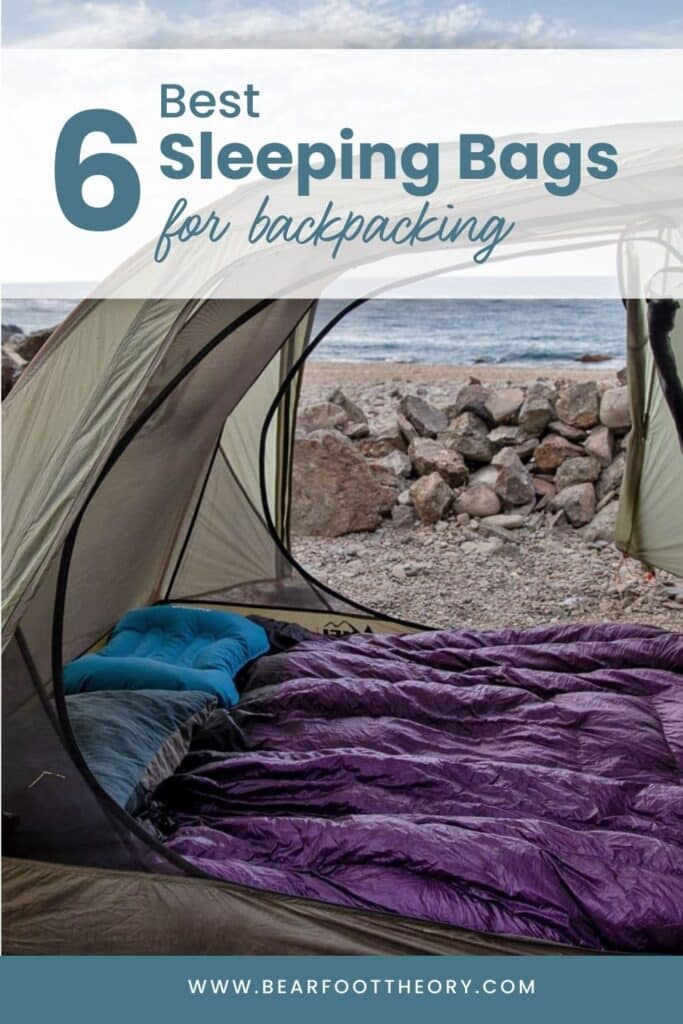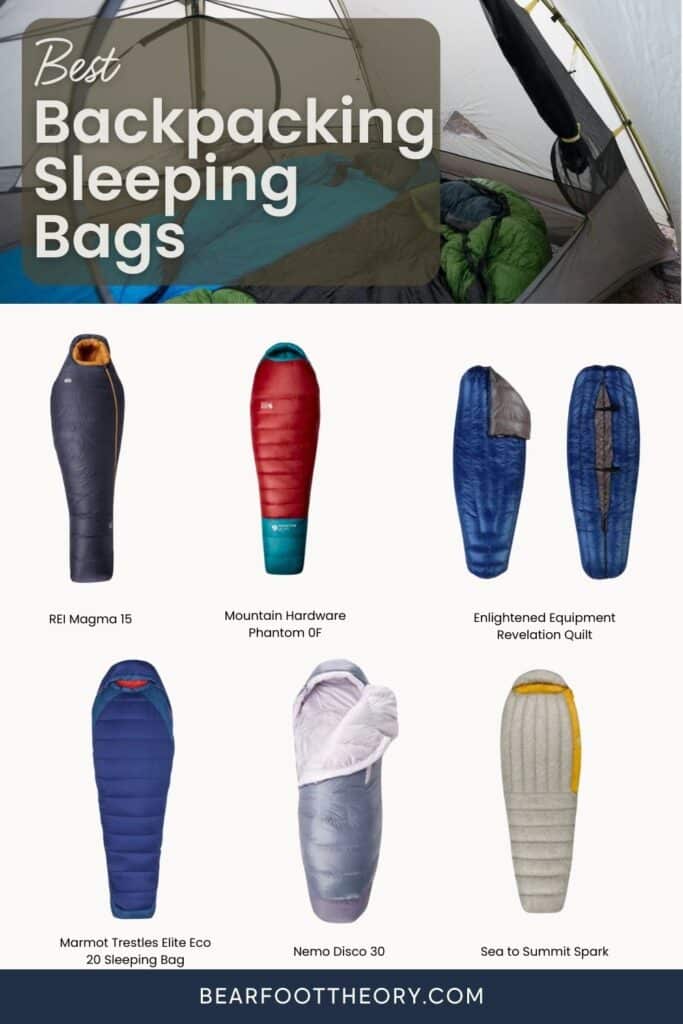6 Best Women’s Sleeping Bags for Backpacking in 2024
Looking for a warm and lightweight sleeping bag? Here are my favorites that have been tested by myself and the BFT Team.
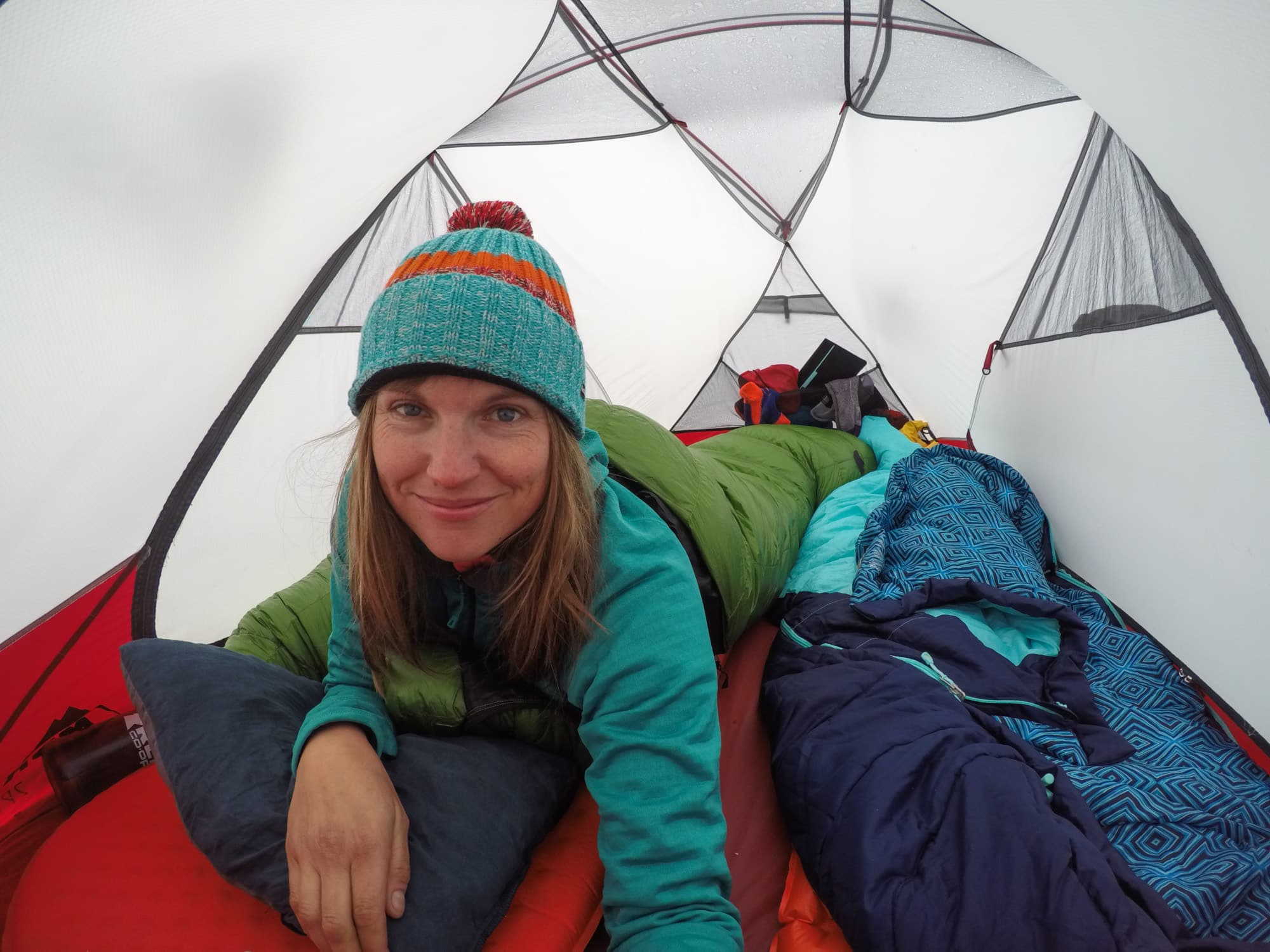
There is nothing that ruins a good backpacking trip than being shivering cold in your sleeping bag all night long. I’ve been there, and it’s absolutely no fun at all.
Over the years, my team and I have tested dozens of sleeping bags different backpacking sleeping bags. Some of them have been awesome (like the ones mentioned below), while others have really fallen short. One time on trip along Utah’s Green River, my sleeping bag was not nearly warm enough, and I barely got any sleep for the entire week. That sleeping bag went straight to the Good Will after that trip.
A quality sleeping bag is one of the first pieces of backpacking gear I recommend beginner backpackers make as it will help you sleep better, but it also will save space and weight in your pack. But it can be confusing trying to figure out which one to buy, analyzing factors like compressibility, temperature rating, weight, and materials.
So in this blog post, I list the 6 best sleeping bags for backpacking that my team and I have tried.

Best Backpacking Sleeping Bags at a Glance
- Best all around: REI Co-op Magma 15 Unisex Sleeping Bag
- Best ultralight sleeping bag: Sea to Summit Spark
- Best backpacking quilt: Enlightened Equipment Revelation Quilt
- Best for side sleepers: Women’s Nemo Disco 30
- Best synthetic sleeping bag: Marmot Trestles Elite Eco 20 Sleeping Bag
- Best 4-season: Mountain Hardwear Phantom Sleeping Bag: 0F Down
This post may contain affiliate links.
Save this post!
Enter your email & I'll send this post to your inbox! You'll also receive my weekly newsletter full of helpful advice for planning your adventures.
REI Co-op Magma 15 Unisex Sleeping Bag
Best All Around Backpacking Sleeping Bag
- Great for: 3-season backpacking, people who are in between sizes or looking for a perfect, custom fit
- What we like: 9 sizes based on height and weight, comfortable for all positions, most sizes are very light and compressible, roomy yet warm foot box
- What we don’t like: small stash pocket
New for 2024, the popular REI Magma sleeping bag has been completely redesigned. The previous version came in both a men’s and women’s bag, but in order to create more inclusive sizing, the new REI Magma is unisex and comes in 9 different sizes, so you can get a completely custom fit based on your height and width.
BFT Contributor Kaylin Zittergruen recently tested out the 15-degree REI Magma Sleeping Bag in the Medium size on a 3-night backpacking trip and loved how comfortable and warm it was. She says, “I had the perfect amount of room so I could roll onto my side and stomach, without having so much space that the bag felt drafty.”
The 15 degree version performed well when the low reached 20 degrees at night and Kaylin reported “I was toasty only wearing a base layer top, leggings, and wool socks.” In addition, “It has an anti-snag zipper so I didn’t have to worry about middle-of-the-night zipper snafus.”
Finally, the compressed volume ranges from 6 liters to 9.5 liters depending on the size. The medium-size packs down smaller than many popular 30-degree backpacking sleeping bags. Even without a special compression sack, Kaylin said “I packed the sleeping bag into the bottom compartment of my 45-liter backpack and noticed I had room to spare, making it easy to quickly stuff the bag in and take it out of my pack.”
The full retail price of the 15-degree Magma is $429 which is middle of the road for sleeping bags with comparable weight and temperature ratings. For the price, quality, and seasonality, this is one of the best backpacking sleeping bags you can buy.

Sea to Summit Spark
Best Ultralight Backpacking Sleeping Bag
- Great for: ultralight 3-season backpacking
- What we like: most lightweight bag on our list, available in multiple temperature ratings to fit your needs, highly compressible
- What we don’t like: doesn’t fit well in the included compression sack
The Sea to Summit Women’s Spark is the best sleeping bag option on the market for ultralight backpacking. BFT Contributor Linda Romero says “it’s by far the lightest and warmest backpacking sleeping bag I’ve ever used.”
The Spark comes in a variety of temperature ratings, so you can decide which best fits your needs. The 45 degree version is less than 1lb (less than some sleeping pads!). Linda says “it packed down to the size of a football in my backpack, saving a ton of weight and space for my other backpacking gear.”
Like the Magma sleeping bag above, the Spark has a water-repellent treatment on the fabric which protects the down from external moisture and condensation. Anyone whose ever dealt with a wet down bag knows that it’s not fun (and can shorten the lifespan of the bag), so this extra protection is an added bonus.
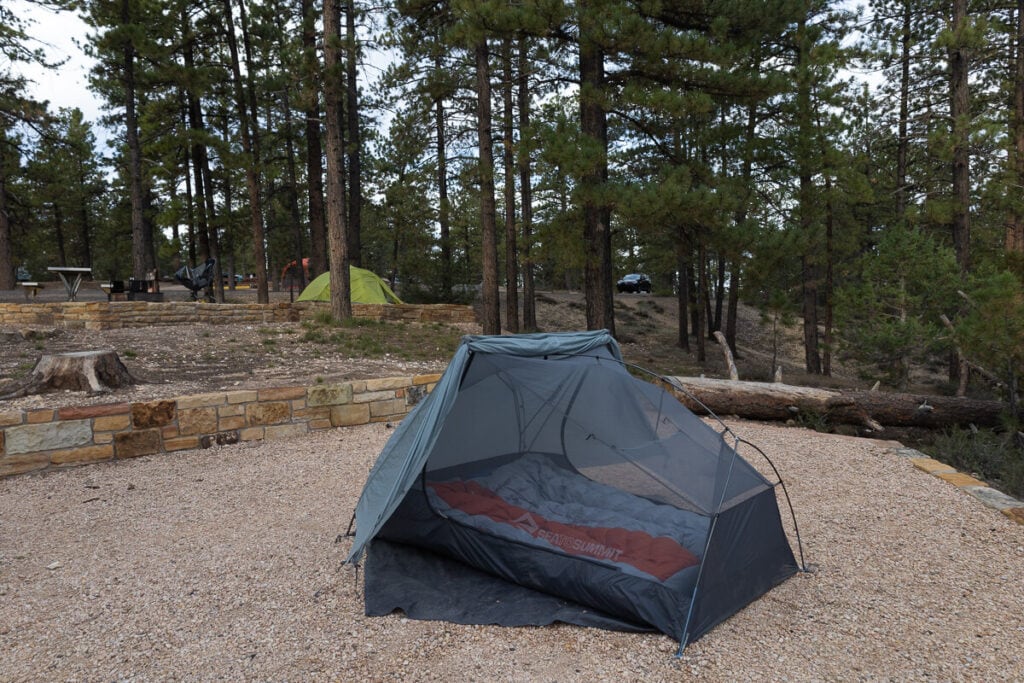
If you prefer a quilt over a mummy bag, the Sea to Summit Ember is the quilt version of the Spark, made from the same high-quality materials and baffling system. BFT Contributor Courtney Stephenson uses the Ember on backpacking trips and says, “as a side sleeper who tosses and turns often, I prefers the quilt vs. a full-zip sleeping bag with more freedom of motion.”
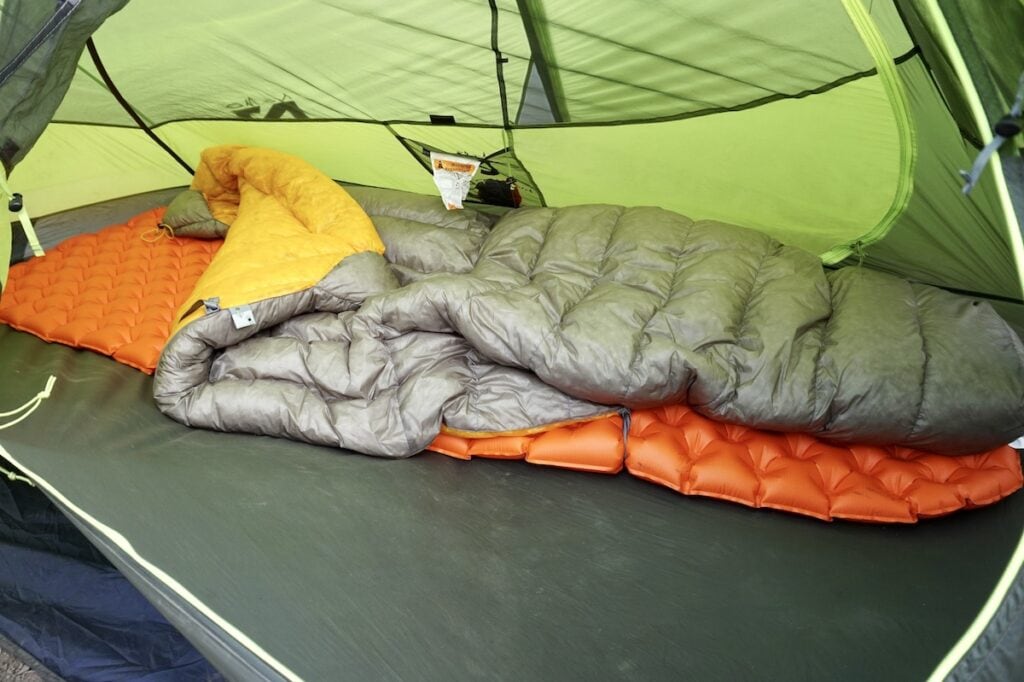
Enlightened Equipment Revelation Quilt
Best Backpacking Quilt
- Great for: ultralight backpacking, 3-season backpacking, people who move around a lot while sleeping or don’t want to feel constricted in a sleeping bag
- What we like: one of the lightest bags on our list, customizable, highly compressible, can easily be used as a blanket around the fire
- What we don’t like: requires a proper sleeping pad for maximum warmth, custom orders can take a while to ship
If you’ve ever considered ditching the sleeping bag for a quilt, Enlightened Equipment’s Revelation quilt is the one to use. This is my favorite “sleeping bag” I’ve ever used as it’s ultralight and ultra-versatile, and it can be customized to your height, desired fill weight, and temperature rating. Like the REI Magma, the Revelation comes in a variety of sizes, so you can get the perfect fit depending on your height and width.
On warm nights, I simply lay the quilt out as a blanket and on colder nights, I cinch the neck collar closed, clip the sides to my sleeping pad with the straps, and zip up the foot box. This design is perfect for thru-hikers and anyone who wants a bag that can be used in various temperatures and climates.
I also find it extremely comfortable, and I feel less confined than I do in a normal mummy bag. The quilt comes with a set of elastic straps that allow you to attach the quilt to your sleeping pad to eliminate drafts and prevent it from shifting around during the night.
Along with the other advantages, even the 0-degree extra-long and extra-wide size weighs well under 2 pounds. The 20-degree regular size weighs 16 ounces and compresses to 7 liters, making it ideal for ultralight backpackers.
Ryan and I also use the Enlightened Equipment 2-Man Accomplice Quilt. I wasn’t so sure about sharing a quilt with Ryan, but we absolutely love it. It feels just like you are sharing a blanket on a bed. Each person is able to adjust their own side, we can snuggle underneath it, and it’s lighter than many 1-person mummy bags. If you’re looking to snuggle up with your partner, check out our roundup of the best 2-person sleeping bags.
The thing I don’t like about the Enlightened Equipment Quilts is that they don’t have a hood, a design intended to shave weight. If it’s cold, I either wear a beanie to bed or Enlightened Equipment also sells a separate Torrid Hood that only weighs 2 or 4 ounces depending on fill. Also since you sleep directly on your sleeping pad, I suggest wearing pants since I find my sleeping pad to be a bit scratchy when it’s directly touching my skin.

Nemo Disco 30
Best for Side Sleepers
- Great for: side and stomach sleepers, people who toss & turn, 3-season backpacking
- What we like: provides maximum comfort, roomy to move around, pillow pocket, foot box is made of PFAS-free waterproof materials which is helpful in protecting the bag against tent condensation
- What we don’t like: doesn’t compress down super well, roomy bags take longer to warm up, loose-fitting stuff sack
The NEMO Disco 30 is one of the most popular backpacking sleeping bags on the market for side sleepers because of the wide cut at the elbows and knees. When you roll over in the middle of the night, it gives you plenty of room to bend your legs and arms so you don’t feel constrained.
This bag has vents on the chest that you can open or close in order to regulate your body temperature without having to unzip the side of the bag.
This new version of the DISCO comes with an “endless promise” – meaning it was designed to stay out of landfills. The entire bag is recyclable (although I suggest repairing or donating if you don’t need it anymore).
People love that this bag can also be zipped together with another NEMO bag (one right zip and one left zip bag will zip together), creating a two-person cocoon.
The thing I don’t like about this bag is it’s heavier than the other bags on this list. The Enlightened Equipment quilt that I mention above is also great for side sleepers and a lot lighter. But if you are a side sleeper set on a traditional sleeping bag, this one is your ticket!
Marmot Trestles Elite Eco 20 Sleeping Bag
Best Synthetic Backpacking Sleeping Bag
- Great for: 3-season backpacking, vegans, wet weather camping, beginner backpackers
- What we like: budget-friendly, holds up better than down in wet weather
- What we don’t like: one of the heaviest and least compressible sleeping bags on our list
The Marmot Trestles Elite Eco 20 Sleeping Bag is a great 3-season bag that offers all-synthetic construction that will keep you warm even in wet camping conditions.
If you are fully vegan and don’t use gear made with animal products, this Marmot sleeping bag is one of the best options available. It’s lighter than other synthetic options, and at $169, it’s also a great price point.
This bag is made from recycled materials, making it a sustainable choice for environmentally-conscious campers. Additionally, the bag features a unique wave construction that helps to eliminate cold spots and provides excellent insulation.
My partner Ryan owns the men’s version of this bag, and he finds it very comfortable. What he doesn’t love is how bulky it is. He says “while budget-friendly, this bag takes up a lot more space in my backpack and is heavier than the down sleeping bags I own.”
Additionally, some users have reported that the bag’s zipper can be difficult to use, which can be frustrating when trying to get in and out of the bag. Despite these minor drawbacks, this bag remains a great choice for anyone looking for a sustainable and reliable synthetic, vegan-friendly sleeping bag.

Mountain Hardwear Phantom 0F
Best 4-Season Sleeping Bag
- Great for: winter backpacking, cold weather trips, people who run cold at night
- What we like: warmest bag on our list, fairly compact for how warm it is
- What we don’t like: expensive investment, bag is quite narrow
The Mountain Hardwear Phantom 0F Down Sleeping Bag is my choice for winter backpacking due to its high-quality insulation and efficient design. With a temperature rating of 0F, this sleeping bag is specifically designed to keep you toasty warm in cold winter conditions.
At 2 lbs, 6oz, it’s very light and compressible for a 0 degree bag. The bag is filled with high-loft down that provides excellent insulation and is still easy to pack and carry. Additionally, the bag features a draft collar and hood that help to trap heat inside and keep you comfortable throughout the night.
For temperatures down to 0 degrees, you can’t find a sleeping bag better than this one. It may be at the top of your price bracket at around $650, understandably. But, with proper care, this sleeping bag should last you a very, very long time.
How to Choose a Backpacking Sleeping Bag
Picking out a new backpacking sleeping bag for any outdoor adventure can be super overwhelming. There are so many choices and so many features to consider, not to mention the price tag. So, I’ve put together this simple guide on how to choose a backpacking sleeping bag for your next great adventure. Hopefully, this makes your gear-buying process easier.
Sleeping Bag Temperature Rating
The sleeping bag temperature rating is the first place to start when picking out a new backpacking sleeping bag. Think about when and where you plan to use it the most.
Sleeping bags can be broken down into three simple categories: summer, 3-season, and winter based on the temperature ratings shown in the table below.

If you are buying your first backpacking sleeping bag, I recommend a 3-season bag which will keep you comfortable for most of the year. Remember you can always zip down the bag for a summer camping trip or add a sleeping bag liner to your bag for an occasional winter camping trip. Most 3-season backpacking bags will list two temperature ratings known as the “comfort rating” and the “lower-limit rating”.
Comfort rating is the lowest temperature at which the bag will keep the average woman or “cold sleeper” comfortable. Lower-limit rating is the lowest temperature at which the bag will keep a man or “warm sleeper” comfortable. Women tend to run colder and for women’s sleeping bag ratings that is often taken into account. Note that ratings are based on a sleeper wearing one long underwear layer and a hat, and sleeping on a single one-inch thick insulating pad.
The number listed with most sleeping bags (example: Nemo Disco 30) is the Lower Limit which is usually 10-15 degrees lower than the Comfort Rating. So, for most people, the Nemo Disco 30 would be comfortable in 40F sleeping temperatures.
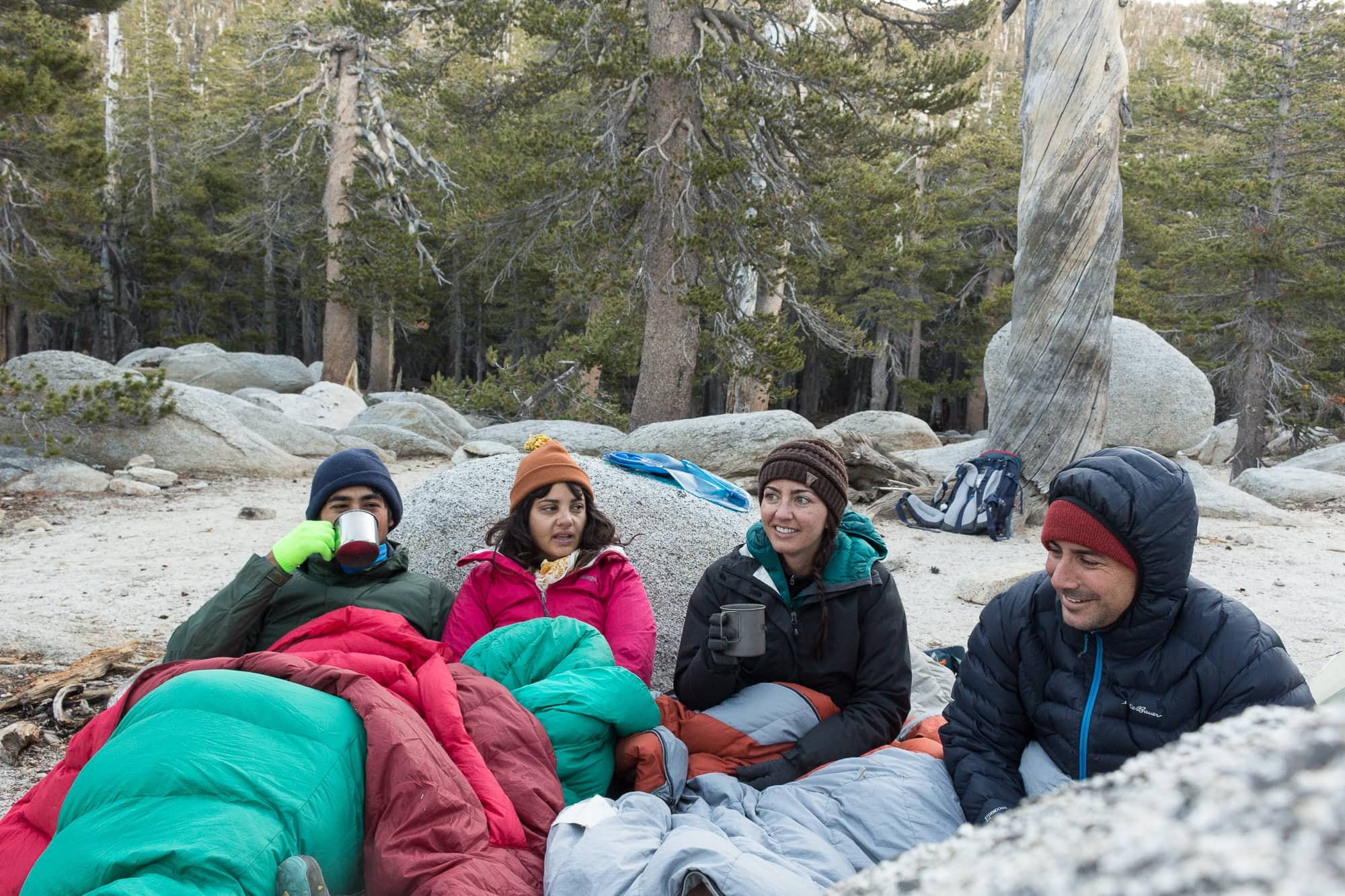
Sleeping Bag Shape
While the sleeping bag shape might not seem important, it is for two big reasons:
First, sleeping bags keep you warm by trapping air and holding it in a layer next to your body. Your body heats up this layer of trapped air to keep you warm. The less air space there is in the bag, the faster you warm up and stay warm! Picking a bag based on your body size and shape is important for efficiency and warmth. Roomier sleeping bags will often be heavier as well, but they will be more comfortable for side-sleepers.
I recommend selecting a semi-rectangular bag or mummy bag which is versatile and can work for backpacking as well as car camping. Semi-rectangular bags are good for backpackers with larger frames or those who don’t like the constrictive feeling of a mummy bag.
To Quilt or Not to Quilt?
Some lightweight backpackers won’t even entertain the idea of a sleeping bag, and instead, opt for a camping quilt. Quilts are a lightweight backcountry option generally designed to be paired with a sleeping pad. It’s basically a blanket with a foot box that will keep you warm without any unnecessary insulation or weight. Quilts offer a better warmth-to-weight ratio since they cut out material that’s normally compressed under your body in a traditional mummy bag.
However, quilts can be more drafty than mummy bags, so in really cold or windy conditions we’d opt for a mummy bag. Be sure to check out Enlightened Equipment if you’re interested in going ultralight with a sleeping quilt. This is the quilt I’ve been using for years, and I’m not sure I’d ever go back to a normal sleeping bag in the summer months.
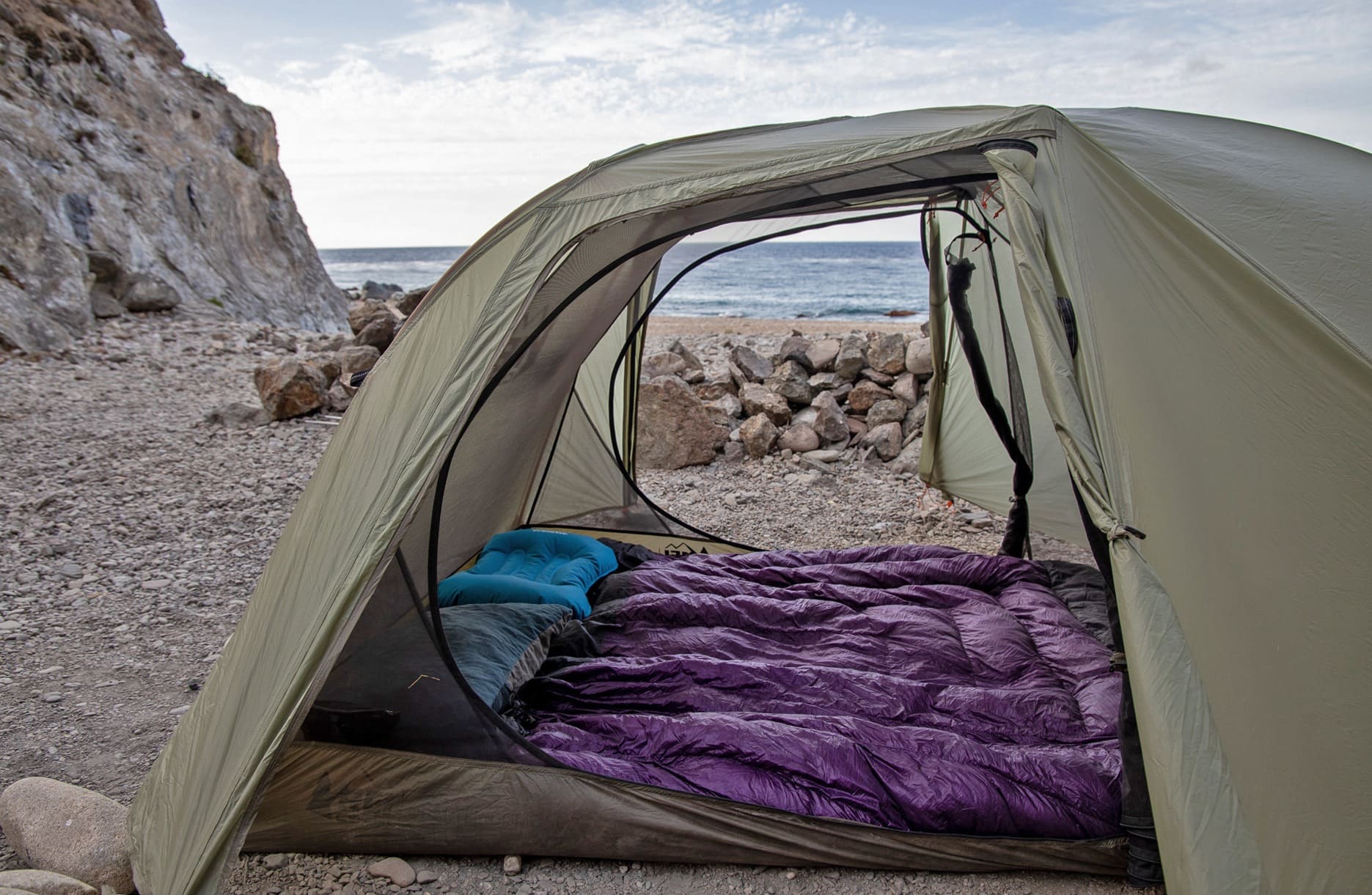
Synthetic vs. Down Sleeping Bag Insulation
Synthetic Backpacking Sleeping Bags
Synthetic sleeping bags are usually insulated with polyester. Synthetic bags are quick-drying and still hold up to their insulation power even when damp or wet. Often, they are cheaper than down, and they’re non-allergenic. One of the downsides of synthetic bags is that they don’t compress as small as down sleeping bags, and they tend to be heavier than down (but that’s not always the case as technology improves). Also, polyester is usually derived from petroleum, although recycled polyester is now being made from plastic bottles and other recycled plastics for more sustainable options.
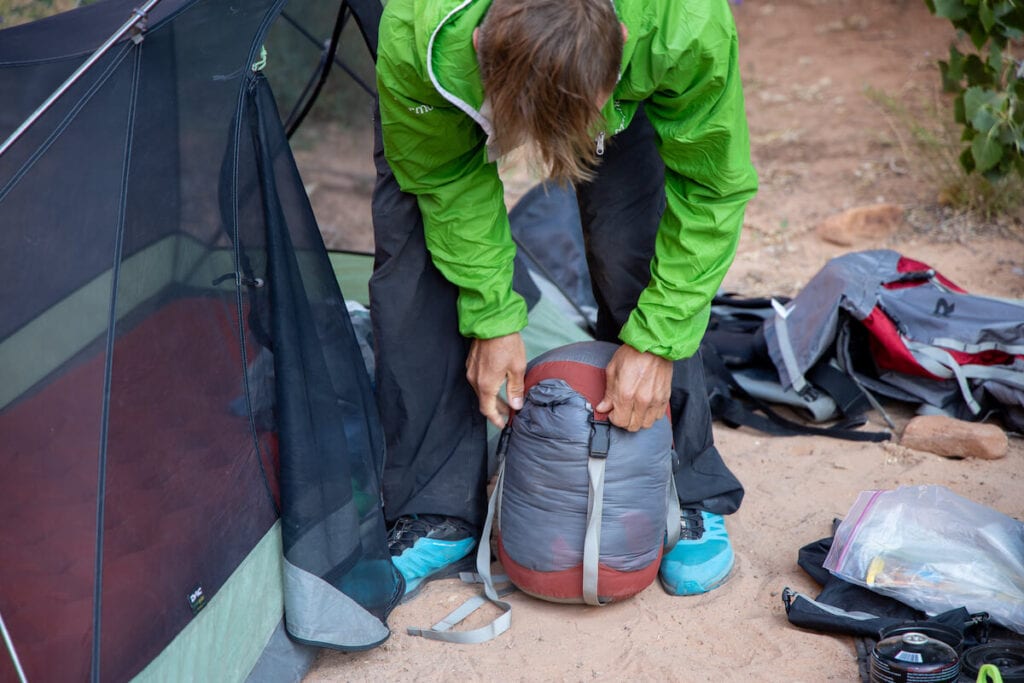
Down Backpacking Sleeping Bags
The biggest advantage of down over synthetic sleeping bags is that down bags tend to be lighter and compress smaller when packed away – key characteristics when you’re looking for a backpacking sleeping bag.
Generally down is more expensive than synthetic, and some people say it’s more durable, so it’s a long-lasting investment. The primary downside to down is that it loses its insulation power when it gets wet. So, it’s most suited for cool, dry conditions. However, many down sleeping bags are now coated with a water-repellent finish that will keep you warm and dry in damp conditions. Otherwise, down sleeping bags are a lightweight, warm, and packable choice for backpacking.
Most of the notable outdoor gear companies have instituted the Responsible Down Standard (RDS), or Global Traceable Down Standard (TDS). These standards ensure that the down and feathers used in these products came from animals that were treated well, and were not force-fed or live-plucked. All of the down sleeping bags listed here are certified to the RDS or TDS.
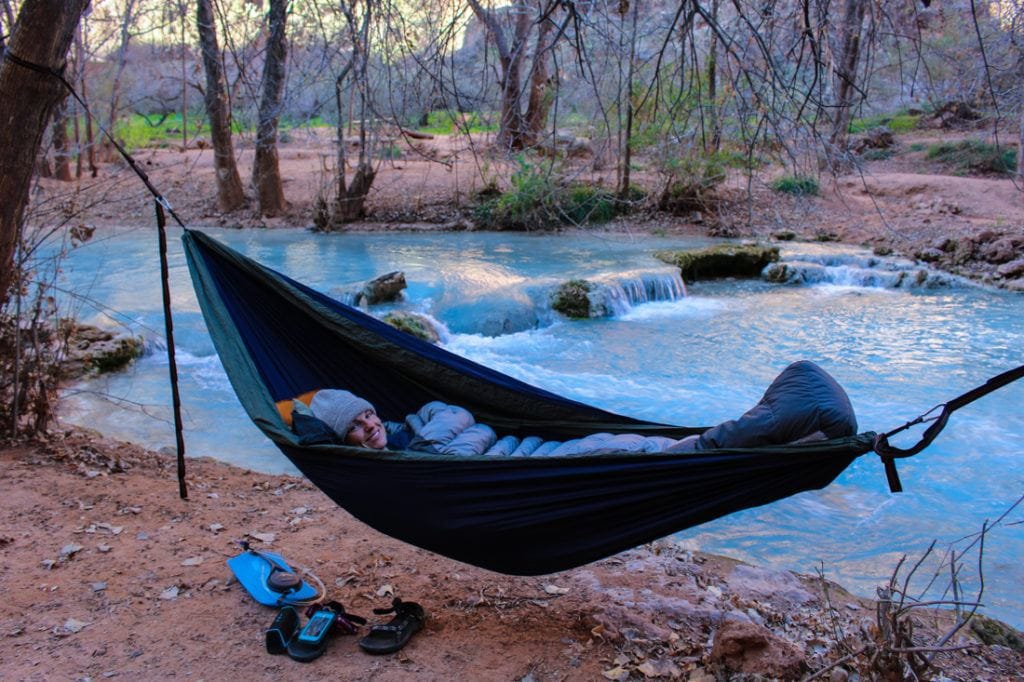
Frequently Asked Questions
You should choose a sleeping bag that is going to warm enough in the variety of climates you plan to backpack in. Typically for mountain backpacking, I’d suggest a 15-degree bag. Even in summer, the temperatures in the mountains can reach freezing, so a 30-degree bag might not be warm enough if you experience bad weather.
It depends on your priorities. If you are on a budget and don’t mind carrying a little extra weight, you can choose a synthetic sleeping bag. Synthetic sleeping bags also insulate better if they happen to get wet, although this is a situation that you should avoid at all costs. If you are looking for a sleeping bag that is lightweight and will compress well, you should choose a down sleeping bag. For these reasons, down is the most popular type of sleeping bag for backpacking.
You should expect to pay somewhere around $300-450 for a sleeping bag that has a temperature rating of 15 degrees, weighs under 3 pounds, and compresses well so it doesn’t take up a lot of room in your pack. Sleeping bags with higher temperature ratings (such as 45 degrees) will cost less simply because they require less insulation and materials to produce. The lighter the sleeping bag is for a given temperature rating, the most it will cost.
It is warmer to wear clothes in side your sleeping bag than to not wear clothes. If you are looking to add warmth, you should wear long johns made of wool or synethic materials and thick wool socks. If you are still cold, I’d recommend adding a down or synethic jacket and a beanie.
Yes! If you are 5’5″ like myself and decide to borrow a sleeping bag from someone who is over 6’0″ tall, all of that extra space will make the bag feel drafty. You want a sleeping bag that is the right size for your height and width in order to provide proper insulation.

